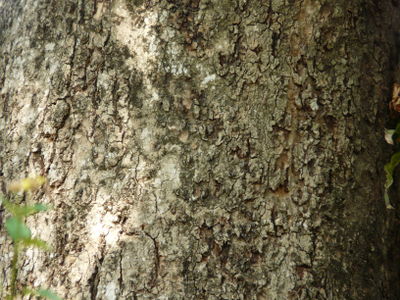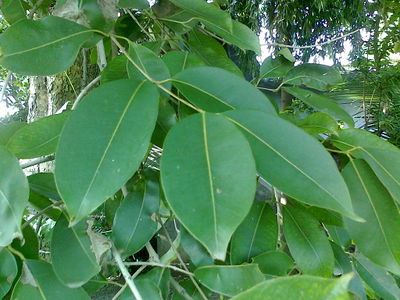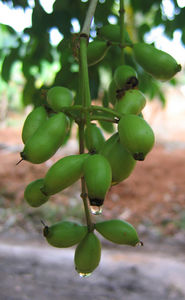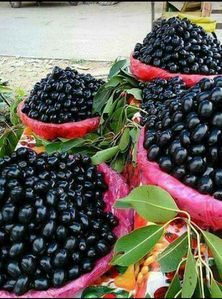Syzygium cumini
Syzygium cumini (L.) Skeels
| Ordre | Myrtales |
|---|---|
| Famille | Myrtaceae |
| Genre | Syzygium |
2n = 22, 42, 44, 66 ?
Origine : nord de l'Inde, Indochine, sud de la Chine
sauvage ou cultivé
| Français | jamelongue*Voir l'étymologie de [[Etymologie des noms scientifiques#|]] |
|---|---|
| Anglais | jambolan |
- fruit comestible
- fruit transformé en vin et vinaigre
- médicinal : fruit, graines, feuilles, écorce
- bois d'œuvre
- bois de feu
- arbre d'ombrage et brise-vent
- ornemental
- feuilles fourragères
- mellifère
- tanin : écorce
Sommaire
Description
Noms populaires
| français | jamelongue, jamblon ; jamblongue (La Réunion) ; tété-négresse (Antilles) |
| anglais | jambolan, Java plum ; Jack Plum ; Damson tree (Jamaïque) (Rollet) |
| allemand | Rosenapfel |
| néerlandais | jambolan |
| italien | jambolan |
| espagnol | yambolana, jambolán, guayabo pesgua |
| portugais | jambolão, azeitona |
| chinois | 乌墨 - wu mo (Flora of China) |
| sanscrit | जम्बु - jambu, जम्बू - jambū, जम्बुलः - jambulā (Monier-Williams) |
| hindi | jāmun ; jaman, jam (Wealth of India) |
| bengali | jam, kalajam (Wealth of India) |
| marathi | jamal, jambul (Wealth of India) |
| gujerati | jambu, jamli (Wealth of India) |
| konkani | zāmbal (arbre), zāmbūl, pl. zāmbuḷām (fruit) (Dalgado) |
| telugu | neereedu (Wealth of India) |
| tamoul | neredam, naval, sambal (Wealth of India) |
| kannada | nerale (Wealth of India) ; ನೇರಳೆಹಣ್ - nerale hannu (Wikipedia en) |
| malayalam | naval, perinnaral (Wealth of India) |
| oriya | jamo (Wealth of India) |
| Nepal | kalajam (Wealth of India) |
| Punjab | jammu (Wealth of India) |
| Mundari | dinkikudadaru (Wealth of India) |
| Lepcha | phoberkung (Wealth of India) |
| Andamans | thabye, jamun (Wealth of India) |
| Philippines | duhat (tagalog, bisaya), lomboi (ilokano) (PROSEA) |
| Indonésie | jamblang, duwet (Java) (PROSEA) |
| Malaysia | jambulana, jambulan (PROSEA) |
| Thaïlande | wa (centre), hakhiphae (Chiang Rai) (PROSEA) |
| Vietnam | vôi rung, trâm môc (PROSEA) |
| Laos | va (PROSEA) |
| Cambodge | pring bai (PROSEA) |
| Birmanie | thabyay-hpyoo (PROSEA) |
Classification
Syzygium cumini (L.) Skeels (1912)
basionyme :
- Myrtus cumini L. (1753)
synonyme :
- Eugenia jambolana Lam. (1789)
- Calyptranthes jambolana (Lam.) Willd. (1796)
Cultivars
Histoire
perin-njara vol. 5 pl. 29 Rheede 1685, Hortus Malabaricus
Cette espèce est le véritable jambu des textes sanscrits, qui appellent l'Inde जम्बुद्वीप - jambudvīpa, le "pays des jambu", d'où coule une rivière de jus de jambu (Wujastyk, 2004).
Usages
In S Asia a very ancient fruit crop, venerated by Buddhists and considered to be sacred to Krishna and planted near Hinduistic temples. Nowadays cultivated in many tropical and subtropical regions in Asia (from India to S China, the Philippines and Indonesia), Africa (Madagascar, Tanzania, Kenya, Ghana, Algeria), America (from California, Florida and the Antilles to Venezuela, Suriname and Brazil), Australia and Oceania; to Israel introduced about 1940. The fruits have a sweet or subacid flavour and are eaten raw or serve to produce tarts, jams and sauces. Jambolan juice is also excellent for making various beverages (e.g. vines and vinegar) and preserves vinegars. Fruits, seeds, leaves and bark of the tree are used in the folk medicine. The tree is also important for apiculture. Jambolan honey is of fine quality. The bark contains tannin. It is used for tanning leather and preserving fishing nets. The red or brownish-gray wood is used in India for various construction purposes.
Références
- Chauvet, Michel, 2018. Encyclopédie des plantes alimentaires. Paris, Belin. 880 p. (p. 495)
- Morton, Julia, 1987. Jambolan. p. 375–378. In: Fruits of warm climates. Julia F. Morton, Miami (Floride). sur NewCrop Purdue
- Orta, Garcia d', 1563. Coloquios dos simples, e drogas he cousas mediçinais da India. Goa, Ioannes de Endem. 250 p. Edité et annoté par Conde de Ficalho en 1891-92. Colloque 28 sur Pl@ntUse
- Rollet, Bernard et coll., 2010. Arbres des Petites Antilles. Tome 1 : Introduction à la dendrologie. 276 p. Tome 2 : Description des espèces. 866 p. + 46 pl. coul. + CD de photos sur l'anatomie du bois. Basse-Terre, ONF. Voir sur Pl@ntUse.
- Wujastyk, Dominik, 2004. Jambudvīpa: Apples or Plums? in : Burnett, Charles et al., Studies in the History of the Exact Sciences in honour of David Pingree, p. 287-301. Academia







